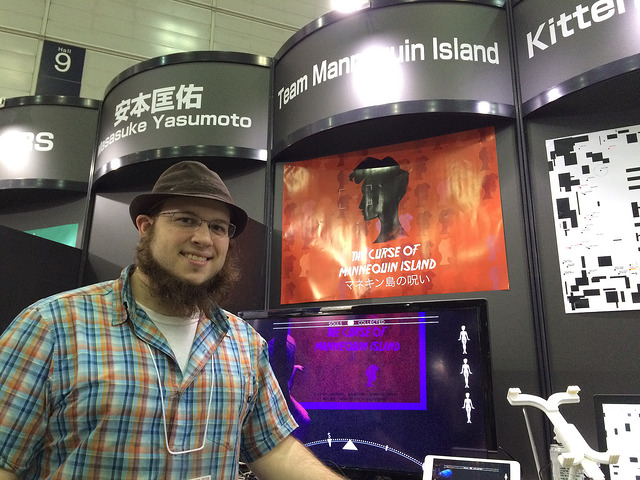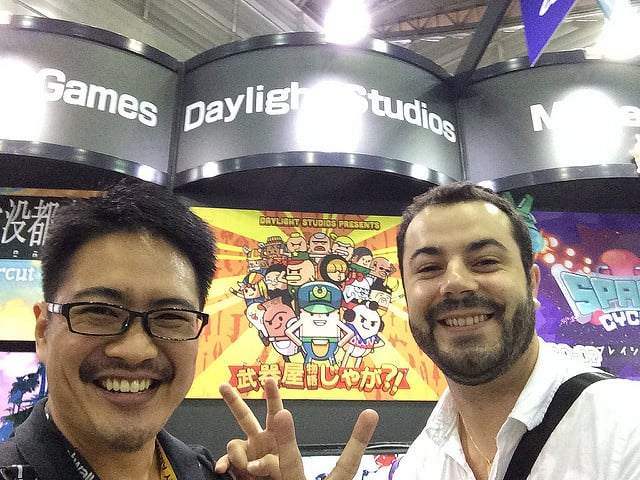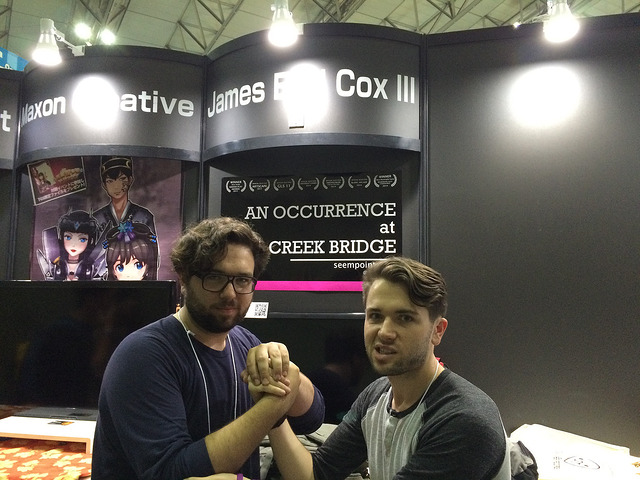
Indie games have once again occupied a humble, yet meaningful place at the Tokyo Game Show 2015. In fact, Sony Computer Entertainment had subsidized the Indie Game Area for a second year in a row. What that essentially means for budding indie and doujin game developers is that what used to cost about $2000 US Dollars is now completely free of charge, and that exhibiting at the TGS is now a matter of submitting a game for demonstration and then subsequently passing the evaluation process. As a result of this opportunity, the Indie Game Area at TGS has been steadily growing in both participation and popularity over recent years, and 2015 has been no exception.
Furthermore, the creative variety of featured games at the TGS Indie Game Area was both wide and global, featuring indie games from Japan, the United States, Singapore, Taiwan, and Australia just to name a few of the countries represented. That degree of global representation notwithstanding, the range of experimental gameplay mechanics, themes, and styles was also as refreshingly myriad and innovative as the people who came to present.
On the academic front, there were strong showings from the University of Southern California and New York University. Prof. Tracy Fullerton (USC School of Cinematic Arts, Game Innovation Lab) and her team showing off Walden, A Game, which is a game which emulates American Transcendentalist David Thoreau’s experience in isolating himself at Walden Pond. Newly-graduated students from NYU presented The Curse of Mannequin Island which is a playful take on the horror genre, which incorporated a photography-based combat system akin to the Fatal Frame series.
In terms of intriguing art styles, the offerings of publisher Ysbryd Games were unusual but in a nostalgically charming way. The game entitled VA-11 HALL-A (more easily referred to by the name “Valhalla”) from Sukeban Games is a refreshing cyberpunk bartending simulator featuring a cast of characters which look like the best of 80’s anime, and an art style that looks like the pixelated love child of Ridley Scott’s Blade Runner and Tochimiki Suzuki’s Bubblegum Crisis. And I mean that in the best of ways. In Valhalla, your success or failure as a bartender has a direct influence on how much of each of the characters’ stories you can coax out of them in any given playthrough. Additionally, I personally find it amazing that Sukeban Games, who hail from Venezuela, were able to create a game that was so very Japanese in terms of aesthetics and tone. Christopher Ortiz of Sukeban Games explained that “it's ‘retro-futuristic’, as in, it looks like what people thought was going to be the future back in the 80's. During that time the US was under the impression that Japan was going to take over the world with its superior technology, so the game looks like the software Japan had in those years. You could say this is a game from an alternate future where Japan did take over.”
Also from publisher Ysbryd Games is the self-styled YIIK: A Postmodern RPG (Ackk Studios). Fans of JRGPs in general will find much of the right kind of familiarity with YIIK, all dressed up in a stylized aesthetic whose Western and Japanese influences are apparent, pleasing, and somehow the right visual complement to the gameplay and level design. In particular, the battle system which was featured in their TGS demo for YIIK featured many mechanics which were apparently inspired by other precedent JRPGs and some new and innovative gimmicks (and furthermore, each character in your party has a different mechanic for combat). Set in the contemporary, 20-something Existentialist world as opposed to any fantasy realm, YIIK is an intriguing title to look forward to in the coming year.
One of the games which caught my eye early on was a whimsical game from Daylight Studios entitled, Holy Potatoes! A Weapon Shop?! (though for full disclosure, the reason for this is mainly because I had happened upon this particular game on Steam a few weeks prior and played the bloody hell out of it). This game is essentially a simulator game akin to Kairosoft’s amazing Game Dev Story (or many of their other offerings), in which you manage a weapon shop, design and produce weapons, and take on special weapon commission work for random potato-ized heroes who are not-so-subtle but warmly rendered homages to outside source material. Aside from the addictive gameplay of Holy Potatoes!, it’s the last bit that I find a particularly telling trait of the indie game phenomenon--all of the inside humor, referencing other popular game characters and tropes (and hitting all the right beats with said humor as well), is more likely to make it into a game that comes from fans, made for fans, as opposed to larger publishers who are likely to omit such humorous inside jokes for the sake of simply not alienating mainstream gamers.
Not only did the indie games featured at this year’s TGS succeed in showing that games can be made by the fans for the fans, but there was also a game there that served as an example of how indie games can challenge the definitions of what actually constitutes the definitions of “game” and “literature.” Joe and James Cox of Seemingly Pointless’ game entitled, An Occurrence at Owl Creek Bridge (based on the short story of the same name by Ambrose Bierce) is an award-winning short game in which the original narrative/plot of the short story for which it is based on is literally distilled into the form and function of a visual game (and you can download this short and brilliant game here). This in and of itself would be an intriguing experiment, but the Cox brothers took it a step further--An Occurrence at Owl Creek Bridge, a game based on a short story from the medium of words and literature, contains absolutely no dialog. The irony of this experimental game serves as a kind of proof of concept that specific works, originally in one form, can be successfully evolved into functional works in the interactive media of games. More precisely, this does not mean that every book or novel can or should be converted thusly, but rather, that for those attempting to push the horizons of storytelling in a static medium further, the good news is, we have An Occurrence at Owl Creek Bridge.
If this year’s TGS Indie Game Area was any indication of the promise of indie games to challenge standard conventions in fun and innovative ways, then we shall certainly be looking forward to seeing the Indie Game Area again at TGS 2016.










Comments
หือ อะไรเนี่ย
รายงานสดจากงานอินดี้เกมครับ บล็อกนอนโกอินเตอร์ ฮะๆๆๆ
ขอบคุณสำหรับบทความคับ ได้แรงฮึดจะไปบ้างงง -
เพิ่มเติมครับ เป็นบทความจากนักเขียนชาวต่างชาติที่ไป TGS2015 ด้วยกันกับทีม Blognone ครับ :-)
Great, Thank you
รับทำเว็บไซต์ ออกแบบเว็บไซต์
เมืองไทยงานเกมมีแต่พริตตี้....ถถถถ
บอทจะทำงานตรวจคำผิดไหม!!!
ถ้าจะเขียนข่าวนี่แล้วลง blognone จะ inception มั้ย 55555
The Dream hacker..
ได้นะครับ BN เคยลงข่าวเดียวกัน 2 ภาษา
คนขี้ลืม | คนบ้าเกม | คนเหงาๆ